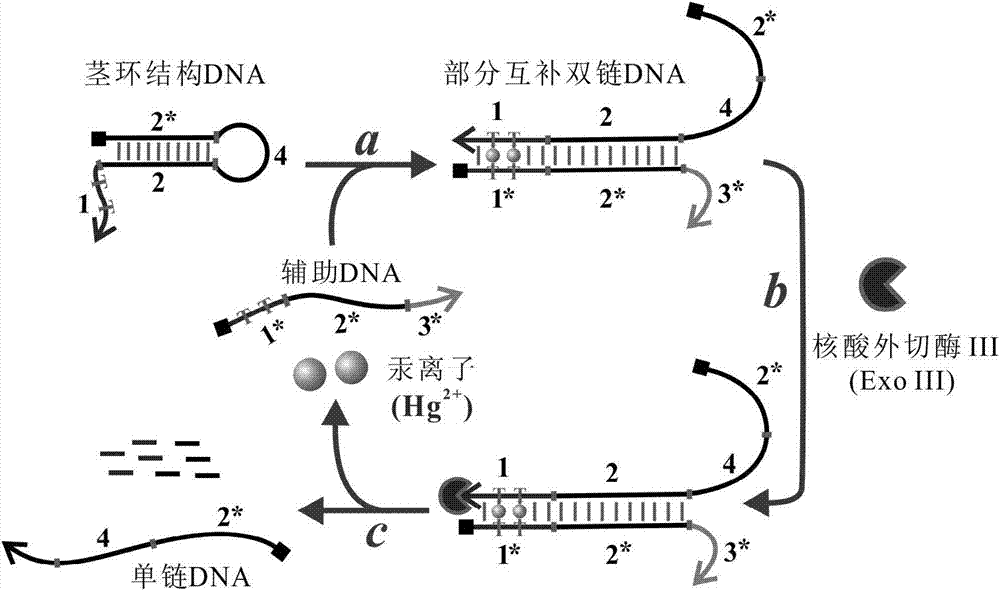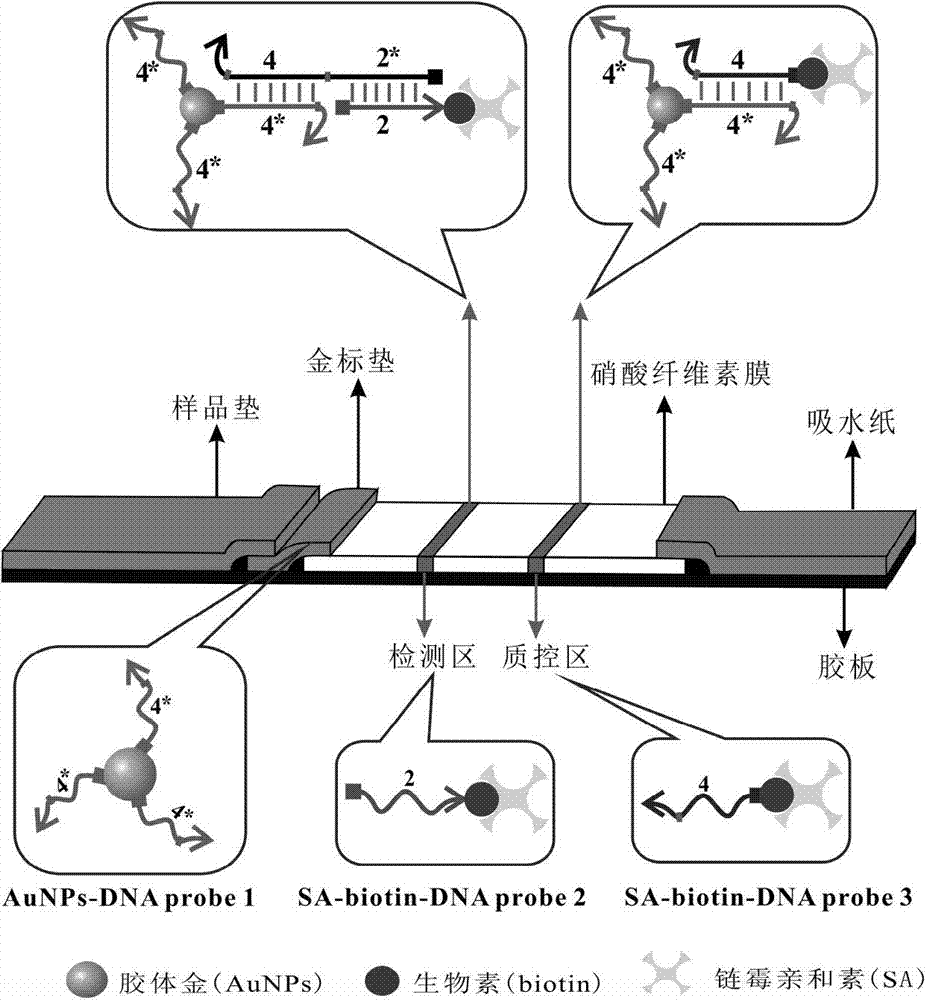Ultra-sensitive detection method of mercury ions and detection kit
A technology of sensitive detection and detection method, applied in the field of analytical chemistry, can solve the problems of low detection sensitivity, difficult to meet the needs of environmental sample detection, etc., and achieve the effects of high sensitivity, intuitive detection results, and convenient detection process.
- Summary
- Abstract
- Description
- Claims
- Application Information
AI Technical Summary
Problems solved by technology
Method used
Image
Examples
Embodiment 1
[0045] The construction of a kind of ultrasensitive detection kit of mercury ion of embodiment 1
[0046] 1. Design of stem-loop DNA and auxiliary DNA
[0047] The sequence of the stem-loop DNA is shown in SEQ ID NO: 1, and its structure is as follows:
[0048]
[0049] Among them, 2 and 2* are complementary, constituting the stem-like region of the stem-loop structure; 4 is the loop region of the stem-loop structure; and 1 region is used to initiate the DNA strand displacement reaction.
[0050] The sequence of the auxiliary DNA is shown in SEQ ID NO: 2, and the structure is as follows:
[0051]
[0052] The 1* region of the helper DNA passes through the formation of T-Hg 2+ The -T complex binds to the 1 region of the stem-loop structure DNA, thereby initiating the DNA strand displacement reaction, opening the stem-loop structure, allowing the 2* region of the auxiliary DNA to combine with the 2 region of the stem-loop structure DNA to form a longer part Complementar...
Embodiment 2
[0066] Utilize the test kit constructed in Example 1 to detect samples, the steps are as follows:
[0067] (1) Use Tris-Ac buffer (20mM, containing 50mM NaCl, 10mM Mg(Ac) 2 , pH7.4) to dissolve the stem-loop structure DNA and the auxiliary DNA respectively.
[0068] (2) Mix 500nM stem-loop DNA and 300nM helper DNA, then add the sample to be tested, mix well, and place at room temperature for 30 minutes. At this step, if there is Hg in the sample to be tested 2+ , the 1* region of the helper DNA passes through the formation of T-Hg 2+ The -T complex binds to the 1 region of the stem-loop structure DNA, and starts to mediate the DNA strand displacement reaction, opening the stem-loop structure, allowing the 2* region of the auxiliary DNA to combine with the 2 region of the stem-loop structure DNA to form a longer partial complementarity Double-stranded DNA (1* and 1 are complementary, 2* and 2 are complementary). Also, the 3' end of the stem-loop DNA forms a blunt end.
[0...
Embodiment 3
[0072] Detection of different concentrations of mercury ions:
[0073] Prepare mercury ion standard solutions with concentrations of 10pM, 100pM, 1nM, 10nM, 100nM and 500nM respectively, and store at room temperature.
[0074] Adopt the method of embodiment 2 to detect the mercury ion solutions of different concentrations, drip the reaction solution (50 μ L) on the sample pad of the test paper, detect at room temperature, observe the detection area of the test paper and the quality control area after 10 minutes Color changes.
[0075] From image 3 It can be seen from the test results that when 10pM mercury ions exist, a clear red area can be observed in the detection area of the test strip, and its detection limit is 10pM, which is far lower than the maximum limit of mercury ions in drinking water stipulated by the US Environmental Protection Agency. The allowable amount is 10nM. And, as the concentration of mercury ions increases (from 10pM to 100nM), the color of the...
PUM
 Login to View More
Login to View More Abstract
Description
Claims
Application Information
 Login to View More
Login to View More - R&D
- Intellectual Property
- Life Sciences
- Materials
- Tech Scout
- Unparalleled Data Quality
- Higher Quality Content
- 60% Fewer Hallucinations
Browse by: Latest US Patents, China's latest patents, Technical Efficacy Thesaurus, Application Domain, Technology Topic, Popular Technical Reports.
© 2025 PatSnap. All rights reserved.Legal|Privacy policy|Modern Slavery Act Transparency Statement|Sitemap|About US| Contact US: help@patsnap.com



